Current Urban Studies
Vol.06 No.03(2018), Article ID:87487,13 pages
10.4236/cus.2018.63022
Social Issues of Urban Road Rehabilitation
W. Supul
Researcher, Colombo, Sri Lanka

Copyright © 2018 by author and Scientific Research Publishing Inc.
This work is licensed under the Creative Commons Attribution International License (CC BY 4.0).
http://creativecommons.org/licenses/by/4.0/



Received: August 14, 2018; Accepted: September 22, 2018; Published: September 25, 2018
ABSTRACT
This study highlights the social issues of an urban road confronted after the recent rehabilitation works. The study reveals that the road has facilitated faster travel with rider comfort but does not provide a very safe place for residents, children of the kindergarten and school and, walkers. The study has identified several social impacts caused by rehabilitation such as walker and resident un-comfort, inconvenience for businesses, not abating environmental pollution, absence of facilities for disable people and several more. Because the road platform is devoid of trees, the motorists, residents and pedestrians are stripped off of an array of benefits. Nor the road design has considered the comfort of walkers especially disable, elderly, sick and children by not providing a fully connected road walkway and not providing any tree shade and benches to have a rest on a hot and sunny day. The road has also not addressed environmental concerns especially the mechanisms for reduction of impacts of particle and other noxious gases emanating from motor vehicle movement on inhabitants. A method to analyze road impacts is included that serves as an aid for future rehabilitation of urban roads.
Keywords:
Tajikistan, Social Urban Road Rehabilitation, Trees, Disable People

1. Introduction
The primary purpose of any road, whether urban or rural, is faster conveyance in travel comfort and safety for all road users including residents. Urban roads in particular have to focus more on safety and other urban aspects of both commuters as well as residents. In the meantime, there are several other issues that road designers, contractors and maintenance agencies must pay attention to in building/rehabilitating and maintenance of urban roads. An inventory of social issues involved in urban road design is therefore a valuable exercise. It is also necessary to note that the type and nature of urban road issues depend on the socio-political climate as well as local rules and regulations of the country in question. The set of social issues is therefore determined by the location of urban road in a particular country.
This article provides a snapshot of social issues diagnosed in an urban road recently rehabilitated in Tajikistan.
Konibodom is a city in the north-west of Tajikistan. With a population of 50,359, it is the 6th largest city in the country1. The city is in a dry area with snow fall in winter. The rehabilitated road is the main means for conveyance between the international border gate with Uzbekistan, for people to travel to the city for work, other needs as well as for residents to connect with the city and the rest of Tajikistan.
The road section rehabilitated in June 2018 is 5.70 km long which forms a part of the 12.40 km road connecting Konibodom City with the border control point with Uzbekistan at a small town called Patar, both are located within the Tajik territory. It passes through high residential area up to about 4 km with the remaining section that has a moderate population density. It is a class II road according to the standards in the country. The road width from ditch-to-ditch varies from 12 to 16 meters. The rehabilitated road section comprises of drain, road platform and other road furniture.
The road section had a large number of fruit and some timber trees on both sides prior to its rehabilitation which began in 2017. The trees comprised of fruit, nut and timber species with a few pine trees. The rehabilitation work has been completed but does not have a tree cover at present.
A study of the completed road section revealed a number of social issues that have not been paid attention to. The study demonstrates that the unattended social issues are important to provide both users’ comfort as well as to ensure their safety. It also uncovered other issues that are considered to be important by the residents, all not excluded the rehabilitation program. The results are useful to formulate a program for maintenance and in the design of urban roads in future.
It is very obvious that the road has helped tremendously for urban commuters and vehicle operators. All interviewed were unanimous in their voice about the benefits of the rehabilitated road for themselves and motorists. However, the outstanding social issues bring a lot of worries to residents, businesses and walkers in particular.
This paper is in two main sections. The first section discusses the current status of social issues after completion of rehabilitation and the impacts thereof. The second section presents a method to analyze social issues that should be considered at the time of road rehabilitation. The tool developed by the author helps to understand social issues and thereby to analyze impacts prior to rehabilitation. This mechanism is useful to designer as well as maintenance agency to manage the road. The beneficiaries of the urban road are provided as a backdrop to the paper.
2. Beneficiaries
There are four main types of beneficiaries of this road section. They are roadside residents, on-site businesses such as retailers, gas and fuel stations, kindergartens, schools, etc., walkers and motorists (Photos 1-3). The study demonstrates that social issues as well as the severity of impacts are different among the four beneficiary groups.
3. Section One: Social Issues
The study reveals 15 social issues confronted by the rehabilitated road section which are discussed in this section. The issues presented have escaped from the road design and continue to be a limitation of the rehabilitated road section.
3.1. Roadside Trees
Prior to rehabilitation, the road section has been lined with a variety of trees
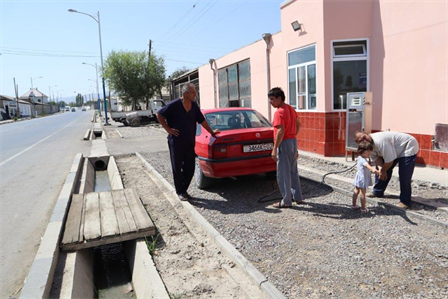
Photo 1. Roadside business.
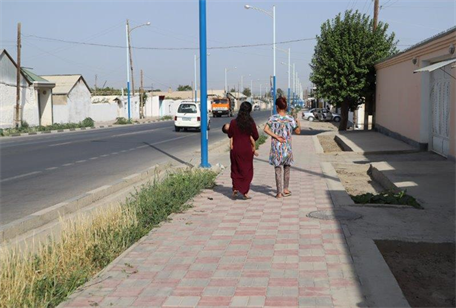
Photo 2. Walkers.
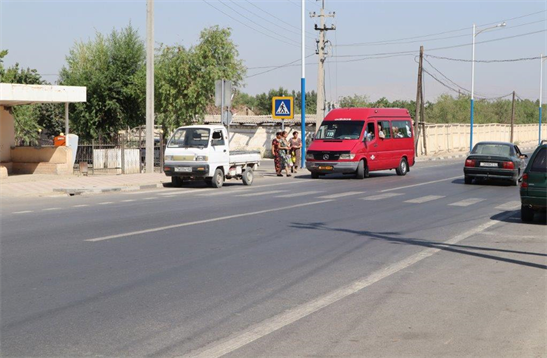
Photo 3. Motorists.
comprising of mainly fruits (apricots, grapes, peaches, apples and fig), nuts (almond and walnut) and wood (poplar, willow). All trees that existed on both sides of road platform were removed as part of rehabilitation.
There are several issues associated with street trees in this road section. First, though the road is well-rehabilitated with smooth surface, platform, ditches, shoulders, underground electric wires and street furniture, is minus any trees now (Photo 4 and Photo 5). People met by the study team, in particular all women met expressed their concern over the absence of trees to minimize the impact of hot sun during June to October. Moreover, all 3 community leaders responsible for the road section identified absence of road side trees as a weakness of the rehabilitation program. The second issue is that the city administration is planning to facilitate tree planting in the autumn 2019. However, it will be entirely pine species, which is based not on a regulation or a practice recommended by research, but a taboo without any valid reason. The residents are expected to follow this prescription and plant pine seedlings procured by themselves in 2019, though their preference is to plant fruit, nut and other trees useful to people and animals. It is noted that women in particular question about the decision to plant pine as their preference based on what existed before is a mixture of fruit-tree species. City Councils elsewhere have a policy to plant and maintain fruit trees along roads. Examples come from several city councils such as Wellington Shire, City of Latrobe (Cambridge City Council, 2005) , etc. in Australia (https://roadsidefruittrees.weebly.com/). However, the Konibodom Council does not have a policy helps administrators to decide on type of trees that should be planted. In the absence of such a policy, it is axiomatic that their personal choice dominates in street planting. Galenieks (2017) based on a study in California points out that poorly conceived policies or the absence of effective policies does not lead to maximize street tree benefits. This conclusion is well

Photo 4. Before.
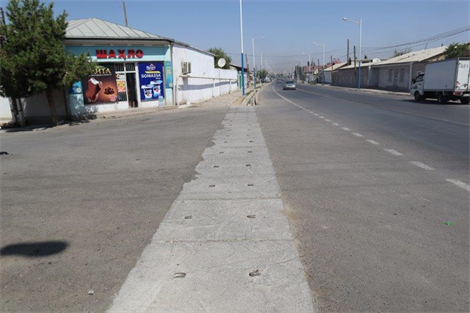
Photo 5. After.
applicable in the case of the Konibodom City. Third, pine will produce neither fruits, wood nor fodder useful to residents, walkers or animals. Hence, residents and walkers will loose the opportunity to pick fruits and nuts from roadside trees in future. The fourth issue is that the road design itself does not accommodate tree planting as the sufficient space has not been made available. In number of places there is not enough space for trees because of the wider road platform. The design could have accommodated trees by narrowing width of road platform in some sections in order to provide more space for trees. Fifth, trees require irrigation water. The road design however, does not facilitate irrigation from the ditch for trees. As a result, residents are forced to use other methods (discussed later) to irrigate their gardens and roadside flower beds. Finally, the road should have deigned in such a way to retain some trees that existed before. Instead, it favored the removal all trees from the corridor. It is to be highlighted that removal of all pre-existing trees does not suit for a dry area such as Konibodom is.
Though the roadside ditch is used to convey water, residents are not provided with a method to abstract it and use for irrigation of trees and plants. Instead, they adopt two methods to abstract water for irrigation. First, the ditch is blocked by packing material such as old rugs, rocks, boards and soil in selected locations (Photo 6). This helps to increase water head in the ditch to a level high enough until it automatically flows into the road platform. The issues are that it floods the street and platform too making it unsafe for walkers and motorists. The ditch and culverts get frequently choked making the system to disfunction. There are also attempts by residents to damage the ditch network when it fails to function, all of which are adding to the city management cost. Second, the frequent wetting and run off over the road impacts the road structure making it does not last long. Another issue is that the cleaning agency has to clean ditch more frequently and thus costs more.
There are few instances where residents have used a garden horse fitted to their house tap to irrigate plants (Photo 7). The presence of horse pipes across road platform can also be a risk to walkers. Moreover, it does give an ugly appearance to the newly built road.
In this environment zone where fruits and nut trees grow well, more attention should have been paid for the strategic use of road space for planting useful trees instead of flowers, the latter provides beauty only during the summer months of May to October. On the other hand, trees provide a long-list of benefits and last for several decades, without having to plant every year.
The absence of trees means the four beneficiaries are unable to benefit from urban trees. Studies provide about 25 types of benefits resulting from roadside

Photo 6. Blocked Ditch.
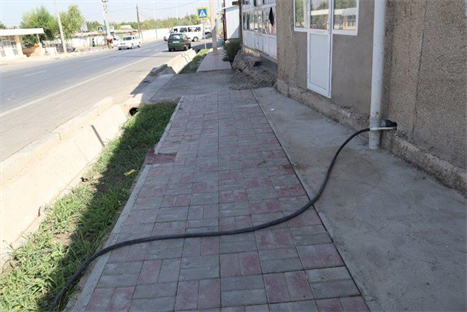
Photo 7. Horsepipe over road platform.
trees (Newcastle City Council, 2016; Cambridge City Council, 2005; Burden, 2006; California Releaf, n.d.) . Such benefits are accrued to all road users including motorists. The sources reveal that trees provide several beneficial impacts on motorists such as reducing driver fatigue, making signs more visible, safe driving, etc. thus contributing to reduced road accidents and improved driver comfort.
3.2. Planting Flowers
The new road design has allocated a space adjacent to the ditch for planting flowers and annual plants (Photo 8). This was not available for residents in the past, is not the preferred option. The residents however, have commenced planting not only flowers but also vegetables, grain and fodder (for animal feeding). Such planting does give street a green and pleasant appearance but lasts only for a few months. The benefits are much less than trees that existed before. The other issues of planting annual plants are: securing irrigation water from the ditch and that the residents, walkers and motorists will not have the benefits of roadside trees. It is to be highlighted that tree scape in urban road provides about 25 different benefits which are applicable in here as well.
3.3. Irrigation Design
The ditch network has been built in the past to provide irrigation water to roadside trees and garden plots of residents. The program of road rehabilitation has removed all pre-existing ditches and replaced with a pre-caste ditch, without analyzing the nature and how it functioned before. The new design has not fully considered the supply of irrigation water from the ditch. For example, the difference in height between ditch bottom and individual pipe inlet connected to garden plots (inside home garden) does not allow a gravity flow directly into the garden. This has made residents to adopt other local methods to obtain irrigation water as already discussed earlier. The irrigation-related issues should have
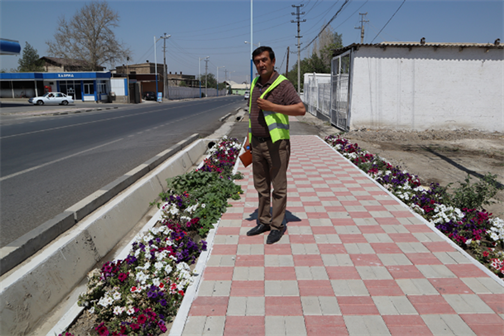
Photo 8. Roadside flower beds.
been considered by the designer to provide a better and less-cumbersome method to supply irrigation water while protecting the road and minimizing canal and road maintenance cost.
3.4. Pedestrian Walkway
The rehabilitated road has a pedestrian walkway which is tiled. It is a huge improvement compared to the unlined and earthen walkway that existed before. The elderly people find it easy to use the rehabilitated walkway albeit it does not support the disable people (discussed later). Another issue yet to be resolved is the disconnect in the walkway especially over cross-ditches where it has not been built. Residents are unable to build it by themselves either which is a main limitation of the road platform.
3.5. Other Obstructions
Obstructions such as electric poles, uncovered open man-holes and gas pipes located on the road platform or on the street are deadly risks to walkers as well as motorists. Live electric cables are either exposed or in contact with running water in the ditch in several locations, causing serious risks of being electrocuted. In future road design, it is necessary to consider all potential obstructions and provide engineering solutions so as to ensure the safety of road users.
3.6. Ramp
The issue is in the past, every house and business had an asphalt ramp from edge of the road up to the door step. The new design has built it from road edge across the platform but short of the door step. This is a concern faced by residents and businesses. Although some businesses are able to fix it by themselves, it remains a problem for most residents especially the poor households who cannot afford to pay for it. Another related issue is that the kindergarten neither has a ramp nor a covered ditch. This is a serious issue that affects the safety of children and their caregivers who visit the kindergarten regularly. On a similar note, the school has neither a ramp flushed with the pedestrian crossing nor a covered ditch. These are high-risk safety issues for both small and big children in particular.
3.7. Open Ditch or Closed Ditch?
Part of the ditch system is open whilst the other part is closed. Which option, open or closed-ditch, is cost-effective is assessed below.
The rehabilitated road has nearly 8000 M of concrete ditches on both sides. An eighty-six percent is open and the remainder (14%) is closed ditch. The open ditch makes it easy for residents to collect water as explained earlier. On the other hand, the area occupied by an open-ditch cannot be used for any purpose other than conveying water. By covering the ditch, it affords water conveyance whilst making it possible to use the space for other purpose. It is to be noted that 9040 M2 of open-ditch area is valuable urban land that cannot be put into an alternate use. The market value of 100 M2 of land in the city is $2500 - 3000. This gives us the land value of the open-ditch area of 9040 M2 which is about Dollars 226,000 to 271,200.
On the other hand, the cost of making a one meter-long of lid for the ditch is Dollars 54. By converting open-ditch to closed-ditch would cost an additional amount of Dollars 369,530. The value of urban land that above conversion makes available for other use is Dollars 226,000 to 271,000 which is only Dollars 163,130 less than construction cost. This calculation shows that the option to convert open ditches to closed ditch though economically not attractive at current land price might be useful in the future. It is to be highlighted that the value of a closed ditch in terms of prevention of accidents is substantial and is likely to outweigh the additional construction cost.
In any case, the high-risk sections such as near kindergartens and schools, the ditch should be closed regardless of construction cost that provides a safer space for children and walkers.
3.8. Roadside Toilets
The rehabilitated road section does not provide public toilets. The only option for walkers is the toilet of 3 - 4 businesses that are available for its clients. Though the local custom allows road users to make use of the toilet within businesses, is not the ideal option for walkers visiting the city from rural area. Providing toilet facility for road user is an important issue considered by road designer and the funding agency elsewhere. For example, provision of roadside rest rooms (toilet and sitting area) is the policy of the Government of the Philippines allowed in all road construction and rehabilitation projects (DPWH, 2014) . In any case, all developed countries provide toilet facility for road user.
3.9. Bus Stops
The rehabilitated road section has only 3 bus stops (as against 5 before) that is a concern to commuters and motorists. In the absence of bus-stops at important locations, the drivers halt the bus at every place where commuters are gathered for boarding. This is a safety as well as a nuisance to road users as well as residents. The request has been made to the authorities to build few more bus-stops in considering the needs of the community.
3.10. Business Space
As explained earlier, the space for business operation in the rehabilitated road section is very limited. Except for 2 fuel stations, all other businesses have only a small area for operation (Photo 1). Few small businesses do not have own space which use the road platform instead, making it inconvenient for residents and walkers. The option of closed ditch that provide an additional space to be used by roadside businesses has also been mentioned earlier. Providing a better business space is an issue for consideration in future design for similar roads.
3.11. Road Signs
The design has not incorporated all road signs. Moreover, some signs are a nuisance to both walkers and motorists. A sound design of road signs should have adopted for this urban road. Another issue as discussed below is that education for residents and motorists on road signs has not been implemented. The ill-effects of poor signs combined with the absence of user education would add to urban road accidents.
3.12. User Education
It is necessary to plan and conduct user education covering road signs as well as on ditch blocking, abstracting irrigation water, tree planting including the use of small space for tree planting, tree pruning and watering trees planted. These activities are yet to take place in this area. Ideally, it should have commenced together with rehabilitation work with the involvement of residents in traffic control work. The road show, open day and other similar events to create an awareness of residents and others on above issues are important but yet to be planed. It is hoped that the relevant government agency takes this important task on board to conduct user education as well as facilitation of street tree planting, the latter to begin in the next planting season.
3.13. Disable Access
It is to be highlighted that the rehabilitated road is not disable-friendly. There are no ramps, no rails to climb stairs and no resting areas supplied with seats. Moreover, the disconnected sections of the road platform are a challenge for people with disability. This suggests that disable people by themselves cannot use the newly rehabilitated road. Such people need the assistance of a non-disable person to walk along. It is to be noted that in other developing countries such as Philippines, it is government policy to provide disable-people friendly roads throughout the country (DPWH, 2014) .
4. Section Two: Importance of Social Issues
Using a matrix, this section presents the importance of social issues involved in urban road rehabilitation. The matrix incorporates 15 social variables identified based on the environment within which the current urban road operates. The degree of importance of each variable to road user is assessed using a scale ranging from 0 to 10 where “0” corresponds the lowest (not relevant or not important at all) whilst number 10 represents the most importance (or most preferred). For example, the first variable is “presence of roadside trees” which is proven as a benefit for each of the four road users. Thus, each user category was assigned the highest score for this variable by the study team. The matrix showing the score as assessed is presented Table 1.
Table 1. Social Issues Assessment Matrix.
Source: Author’s construct.
The results of assessment indicate that selected social variables are considered to be most important by residents, followed by businesses and pedestriansin a descending order. The social issues evaluated are of least importance to motorists, which is no surprise. Their expectation is an improved driver comfort which is provided by the rehabilitated road anyway.
5. Conclusion
The study reveals the presence of 15 different social issues that affect all four categories of road users to a varying degree. Overall, the adverse impacts are heavy on residents followed by businesses and walkers. The impact of current social issues on motorists is the least. It is to be highlighted that social issues have escaped from the design where most could have resolved if diagnosed at the design stage by a social development specialist. Some of the problems surfaced now are too late to be resolved as the rehabilitation work is fully completed. The absence of road side tree planting policy is another issue that confronts the urban street.
This study provides four lessons for urban road rehabilitation. They are the engagement of a social specialist to work with the design and implementation team right from the beginning. Second, an irrigation specialist to resolve ditch irrigation system that is integrated with the road would have improved road benefits to residents. Third, it is necessary that the local government agency prepares a street tree planting policy, which is a good practice implemented by almost all city councils in developed countries. Finally, it is suggested that urban road rehabilitation should be based on the selection of appropriate social indicators for intervention. Moreover, it is necessary that the designer pays attention to each indicator in order to strike an optimum balance of the final design with regard to social issues.
Conflicts of Interest
The authors declare no conflicts of interest regarding the publication of this paper.
Cite this paper
Supul, W. (2018). Social Issues of Urban Road Rehabilitation. Current Urban Studies, 6, 412-424. https://doi.org/10.4236/cus.2018.63022
References
- 1. Australia Web Site on Roadside Fruit Trees. https://roadsidefruittrees.weebly.com/
- 2. Burden, D. (2006). Urban Street Trees-22 Benefits. Glatting Jackson and Walkable Communities Inc., USA. [Paper reference 1]
- 3. California ReLeaf Mission (n.d.). https://californiareleaf.org/whytrees/ [Paper reference 1]
- 4. Cambridge City Council (2005). Why Trees Matter? United Kingdom. https://www.cambridge.gov.uk/media/3263/why-trees-matter.pdf [Paper reference 2]
- 5. Department of Public Works and Highways (2014). Up-Dated Social and Environmental Management Systems Manual of Operation, The Government of the Philippines. http://www.dpwh.gov.ph/dpwh/references/guidelines_manuals/updated_sems [Paper reference 2]
- 6. Galenieks, A. (2017). Importance of Urban Street Tree Policies: A Comparison of Neighbouring Southern California Cities. Urban Forestry & Urban Greening, 22, 105-110. (Short Communication) https://doi.org/10.1016/j.ufug.2017.02.004 [Paper reference 1]
- 7. Newcastle City Council (2016). Street Tree Selection Manual, Australia. [Paper reference 1]
- 8. World Population Review (2018). http://worldpopulationreview.com/countries/tajikistan-population/
NOTES
1http://worldpopulationreview.com/countries/tajikistan-population/


